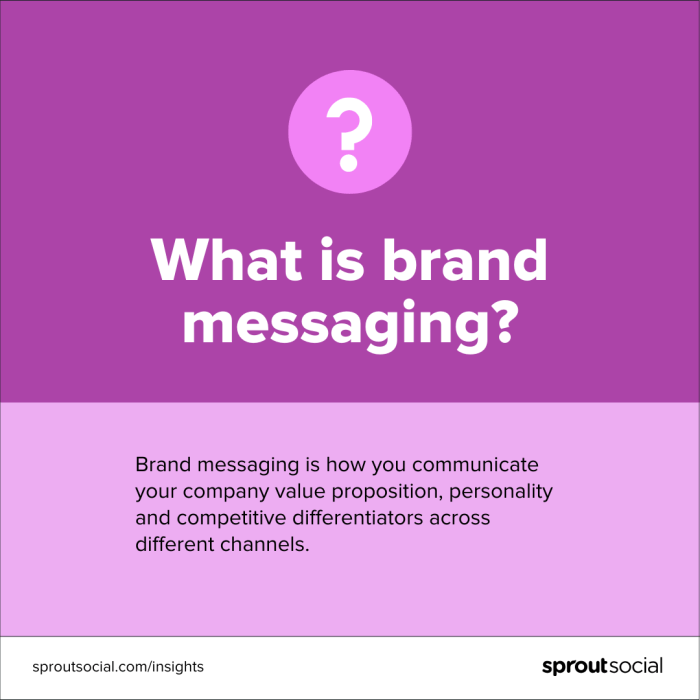Crafting Brand Messaging sets the tone for successful marketing strategies, showcasing the power of words in building brand identity and loyalty. From defining brand messaging to exploring its impact on consumer perception, this topic dives deep into the world of effective communication.
Crafting Brand Messaging

Brand messaging is the way a company communicates its value proposition and personality to its target audience. It is crucial in marketing as it helps businesses establish a strong connection with consumers, differentiate themselves from competitors, and build brand loyalty and trust.
Examples of Successful Brand Messaging Strategies
- Apple: “Think Different” – Apple’s brand messaging emphasizes innovation, creativity, and challenging the status quo.
- Nike: “Just Do It” – Nike’s brand messaging promotes motivation, empowerment, and the idea of pushing your limits.
- Coca-Cola: “Open Happiness” – Coca-Cola’s brand messaging focuses on spreading joy, positivity, and togetherness.
How Brand Messaging Helps Businesses Differentiate Themselves
Brand messaging allows businesses to communicate their unique value proposition and brand personality, helping them stand out in a crowded market. It helps create a distinct identity that resonates with consumers and sets them apart from competitors.
Role of Brand Messaging in Building Brand Loyalty and Trust
Brand messaging plays a crucial role in building brand loyalty and trust by consistently conveying the brand’s values, mission, and promises to customers. When consumers resonate with a brand’s messaging, they are more likely to develop a strong emotional connection and loyalty towards the brand.
Elements of Effective Brand Messaging
Crafting a strong brand message requires careful consideration of several key elements that will resonate with your target audience and set your brand apart from the competition.
Consistency is crucial in brand messaging across different platforms to ensure that your audience receives a cohesive and unified message. Whether it’s on social media, your website, or in advertising campaigns, maintaining consistency in tone, visuals, and messaging helps build brand recognition and trust.
The tone of voice and language used in crafting brand messaging play a significant role in how your brand is perceived by consumers. Whether your brand voice is professional, playful, or witty, it should align with your brand values and resonate with your target audience.
Storytelling is a powerful tool that can be utilized to create compelling brand messages. By weaving narratives that connect with your audience on an emotional level, you can engage customers, build brand loyalty, and differentiate your brand from competitors.
Target Audience and Brand Messaging: Crafting Brand Messaging

When developing brand messaging, understanding the target audience is crucial as it helps tailor the message to resonate with specific demographics, ultimately impacting brand perception.
Significance of Understanding Target Audience
- Knowing the target audience allows brands to create messaging that speaks directly to their needs, preferences, and values.
- By understanding the demographics, psychographics, and behaviors of the target audience, brands can craft messages that are relatable and engaging.
- Effective brand messaging tailored to the target audience can lead to increased brand loyalty, customer engagement, and ultimately, higher sales.
Role of Market Research
- Market research plays a crucial role in determining the most effective brand messaging for a target audience by providing insights into consumer behavior, preferences, and trends.
- Through market research, brands can gather data on their target audience’s demographics, psychographics, purchasing habits, and media consumption, which can inform the messaging strategy.
- By analyzing market research findings, brands can identify key messaging themes, tone of voice, and communication channels that resonate with the target audience.
Personalization in Brand Messaging
- Personalization can enhance brand messaging for specific consumer segments by making the message more relevant and tailored to individual preferences.
- By using personalization techniques such as addressing consumers by name, recommending products based on past purchases, or creating customized content, brands can create a more personalized and engaging experience.
- Personalized brand messaging can help build stronger connections with consumers, increase brand loyalty, and drive repeat purchases.
Brand Messaging Channels
In today’s digital age, brand messaging can be communicated through various channels, each offering unique opportunities to connect with target audiences. Adapting brand messaging to suit different channels and platforms is crucial to ensure consistency and relevance. Let’s explore how brands can effectively utilize different channels for brand messaging.
Digital Channels
- Social Media: Platforms like Facebook, Instagram, Twitter, and LinkedIn allow brands to engage with customers in real-time and share their brand story through posts, videos, and ads.
- Websites: A brand’s website is often the first point of contact for customers, so it’s essential to have clear and compelling brand messaging throughout the site.
- Advertisements: Online ads, such as Google Ads or display ads, offer brands the opportunity to reach a wider audience and reinforce their messaging through visuals and copy.
Offline Channels
- Print Media: Magazines, newspapers, brochures, and direct mail are traditional channels where brand messaging can be tailored to target specific demographics and locations.
- Events: Brand-sponsored events, trade shows, and conferences provide a unique opportunity to engage with customers face-to-face and create memorable brand experiences.
Importance of Adaptation, Crafting Brand Messaging
Adapting brand messaging to different channels is essential to ensure that the message resonates with the specific audience and fits the context of the platform. Tailoring the messaging to suit the format, tone, and style of each channel helps maintain brand consistency and relevance.
Examples of Effective Multi-Channel Brand Messaging
- Apple: Apple consistently delivers a seamless brand experience across its website, social media, and retail stores, with a focus on simplicity and innovation.
- Coca-Cola: Coca-Cola’s brand messaging is consistent across TV commercials, print ads, social media campaigns, and sponsorships, emphasizing happiness and togetherness.
- Nike: Nike’s brand messaging is tailored to different channels, from inspirational videos on social media to interactive experiences at flagship stores, all centered around the idea of empowerment through sports.


